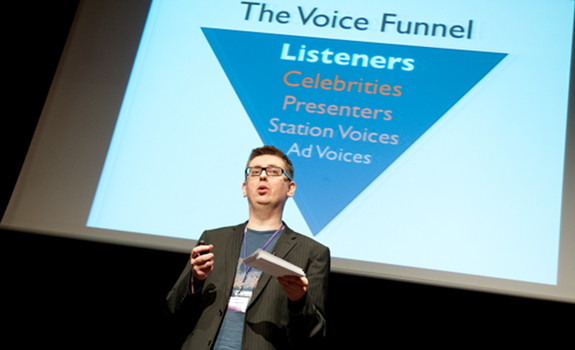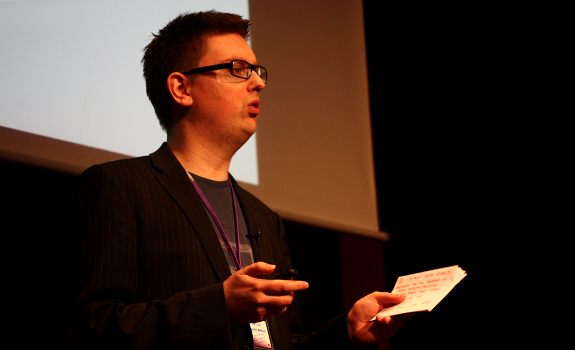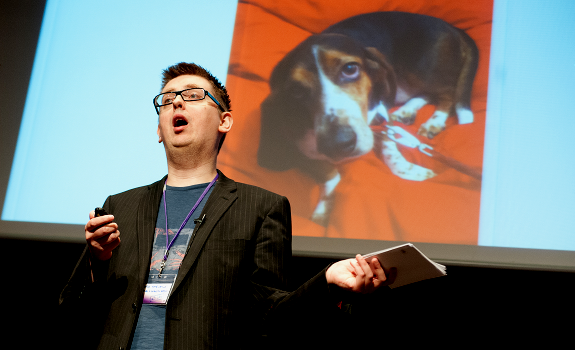What do you want your radio brand to be known for, and do your jingles, sweepers & promos communicate it well? An important question for producers of station imaging.
Chris Stevens was asking it in a fun presentation at NEXTRADIO 2012 about the top 5 ways to improve your station imaging. The Group Production Director & Deputy Group Program Director of Real and Smooth (formerly owned by GMG Radio, now by Global Radio) introduced us to his dog Arthur, to pre-sell a point that he would make at the end.
“Listeners are cynical people;
they have messages thrown at them all day”

Chris Stevens explains why radio audiences consider commercial voiceovers to be the least reliable source, and fellow listeners as the most reliable source of spoken communication, based on the voice funnel (photo: NEXTRADIO)
1. Put radio content first
Chris Stevens knows that station imaging producers are often “obsessed” by technical aspects like audio quality, production effects, plug-ins, and so on. He thinks creative directors should put interesting stories first, and technical quality second.” If you don’t have a story in your production, then it’s not really doing anything of any use. KISS 100 [now KISS] had a brilliant sweeper campaign where they went around and recorded underground stations: ‘the next stop is Holborn, this station is KISS 100’. The audio was really low-quality, because there are pretty low-quality speakers in the underground to start with, but it meant something to the listeners.”
 Tell listeners relevant stories
Tell listeners relevant stories
Stevens was 12 years when he was impressed by Operation Christmas Child, a charity event on MFM [now Heart North West and Wales]. They had people fill shoeboxes with gifts for children in Romania, and received enough to load up an airplane. During a remote broadcast from the airport, they got a special guest on the phone: Michael Jackson. The poor audio quality of the phone line didn’t matter: “Everyone listened, because it had a story to it.”
2. Ensure station imaging credibility
“Listeners are cynical people; they have messages thrown at them all day”, Chris Stevens reminds us. “They don’t believe as much as they’re used to.” He mentions five types of voices and places them in what he calls a voice funnel. The closer a voice is to the top of it, the sooner people are likely to believe what’s being said. Of course, voiceovers in commercials are the least trusted source for listeners as they are being paid to sell. Station voices sound more and more like sellers, too, and even radio personalities are guilty to some degree: “How often are your presenters saying nice; useful; interesting things? How often are they selling a sponsor; a station event or something like that?”
“We throw anything on the air,
just to keep the amount of voiceover down”

Real Radio and Smooth Radio creative & programmer Chris Stevens likes to use hot clocks to create a variety station imaging format by spreading different sorts of radio imaging throughout the program hour (photo: NEXTRADIO)
Play radio listener testimonials
Closer to the beginning of the funnel are celebrities, although their credibility is at stake as well because they endorse a lot of stuff. “Can you believe a celeb’s tweet anymore if they say they like something? Are they being paid? Who knows.” According to Stevens, listeners are always trusted by the audience because they are genuine people. “When you’re doing production and imaging, can you move your things up the funnel and get a voice that is a little more trusted?”
 3. Schedule radio imaging smartly
3. Schedule radio imaging smartly
“The worst radio producers are the ones that lock themselves away for 18 hours a day in their studio, making the most perfect 10-second piece of audio you can imagine, but have no clue or interest how it is going to be played out across the station”, Chris Stevens says. Jack FM in the USA is using a program clock called The Jack Diamond – :-) – also to define what sort of production element is being used on each position in the hour. “They limit their station voice to only being on about 5 or 6 times an hour, so that it doesn’t burn out.”
Create production sound variety
Stevens has a similar challenge with Smooth Radio, that he looks after from his position as Production Director & Deputy Program Director. “We play 15 songs an hour and don’t do much else, which means there’s a lot of call for imaging and a lot of chance of stuff getting burned out. So we throw anything on the air, just to keep the amount of voiceover down.” Therefore, Smooth Radio is using audience testimonials in between songs as well. And instead of using their voiceover all the time, sister station Real Radio simply interviewed a listener about a prize she won on air, and mixed these quotes with airchecks from the day she won to produce a contest backsell promo:
[audio:http://www.radioiloveit.com/wp-content/uploads/chris-stevens-real-radio-smooth-radio-nextradio-2012-01.mp3|titles=Real Radio Contest Backsell Promo]
“What you share with people,
is what you get remembered for”

Chris Stevens uses his dog Arthur to demonstrate the importance of realizing what you want your audience to remember – and making sure that you consistently communicate it in your station imaging (photo: NEXTRADIO)
4. Keep radio imaging functional
“No-one listens to the radio for imaging”, Chris Stevens says, looking for the listener’s perspective. His advice is to kill your darlings: “If your promos are 40 seconds, maybe they can be 30 seconds; if you’ve got a 5-second sweeper, make sure you do something useful with it.” He plays an example of a pretty long news jingle that Real Radio has been using in the past, and calculates that when they cut off 10 seconds of it, they were saving 1 full day of broadcasting time a year! In addition to the news imaging bit, listen to a time check sponsor message that is short & sweet, and still communicates the advertiser’s brand name:
[audio:http://www.radioiloveit.com/wp-content/uploads/chris-stevens-real-radio-smooth-radio-nextradio-2012-02.mp3|titles=Real Radio News Jingle and Sponsored Time Check Example]
 5. Communicate brand values consistently
5. Communicate brand values consistently
“Be known for something through your imaging, and get known for the right thing” is Stevens’ advice for imaging producers and creative directors. “Jack FM have always really cool; fun; crazy imaging on the air, but they’re still known for Playing What We Want. Capital FM have really modern imaging, but they’re still all about hit music. What are you known for, and is it coming across in your imaging?” is his takeaway question to which every radio creative should know the answer.
Position radio brand first
Chris Stevens emphasizes this point by explaining that BBC Radio 1 would have a big problem if they would have branded only Chris Moyles (who has been replaced by Nick Grimshaw) for all the years that he was the station’s morning anchor, instead of mainly promote the radio brand. “What you share with people, is what you get remembered for; share it correctly. Which is why, probably, you forget everything I say – but remember Arthur, my dog.”
Read also:
- Production (related articles)
- BBC Radio 1 Station Imaging Secrets Unveiled
Stay tuned, follow us @RadioILOVEIT and click below to share this post:





Thank you, Tony!
Happy radio weekend, and stay tuned,
Thomas
Awesome stuff.
Thanks, Thomas!
Hey there, Kelvin – glad you’ve found it helpful.
Keep up the good work!
Cheers,
Thomas
I will put that into practice now that I am a young station imaging producer.
Thanks!